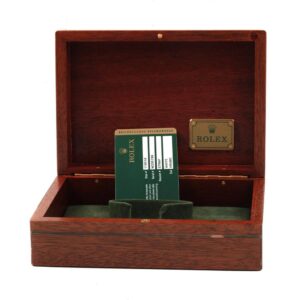The Rolex Daytona Watch You Can’t Buy, Only Win

The Rolex Daytona is one of the most recognizable watches globally, famously worn by actor, race car driver, and philanthropist Paul Newman. However, another racing legend, Sir Malcolm Campbell, also played a pivotal role in its development into the iconic watch we know today. 
In 1935, Campbell made history by breaking the land-speed record, becoming the first driver to exceed 300 mph in his 2,500-hp “Bluebird.” After this feat, Rolex gifted him one of their early dual-register chronograph watches, the reference 2508. This type of chronograph, featuring a tachymeter scale to measure speed over time, was a perfect fit for race car drivers. As the popularity of automobiles surged, Rolex refined its chronograph designs specifically for the racing world. 
By 1954, Rolex had introduced the reference 6234 chronograph. With a hand-wound Valjoux 72 movement, Oyster case, three sub-dials, and a tachymeter scale, this model laid the groundwork for the later Daytona. Production of this model continued until 1961.
In 1962, Rolex became the official timekeeper of the Daytona International Speedway, solidifying its connection with motorsport. The following year, the brand upgraded its Oyster-cased chronograph to reference 6239, which marked the birth of the first true replica Rolex Daytona. Initially called the “Le Mans,” Rolex quickly renamed it to “Daytona” to appeal to the American market, printing the name beneath “Cosmograph” on the dial.
In 1965, Rolex enhanced the Daytona with screw-down pushers and crown, increasing the water resistance of the Oyster case. This reference, dubbed 6240, led to numerous versions of both water-resistant and non-waterproof Daytonas, though non-waterproof models were phased out by the early 1970s.
During this period, Rolex outsourced certain components, such as dials, to external suppliers. One such manufacturer, Singer, created a series of “exotic” dials with unique fonts and colors. Initially unpopular, these dials eventually gained fame when Paul Newman was seen wearing one. By the 1980s, Italian collectors dubbed the rare variation the “Paul Newman” Daytona, and its value soared in the collectors’ market.
The Daytona story didn’t end with the manual models. In 1988, Rolex introduced a modern iteration powered by Zenith’s El Primero automatic movement. The reference 16520 featured a 40mm case, contrasting timing tracks, and a sapphire crystal, bringing the Daytona into a new era. This generation of Daytonas was produced until 2000, when Rolex debuted an in-house movement with six-digit serial numbers, reconfigured sub-dials, and a 72-hour power reserve.

The current model, reference 116500LN, introduced in 2016, features a ceramic bezel and is available in both steel and precious metal versions. Though today’s wearer may not need its original racing functions, the Daytona’s allure has never been stronger. Modern editions of the replica watch are in such demand that waitlists stretch for years.
Rolex became the title sponsor of the 24 Hours of Daytona in 1991. Since then, each winner of the race is awarded a steel Daytona with “24 Hour Winner” engraved on the case back – an honor that perfectly encapsulates Rolex’s deep and enduring connection to racing.